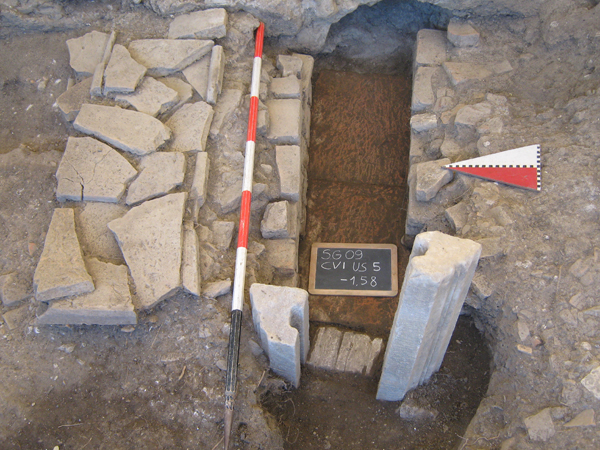Vada Volaterrana,main centre of the Volaterrae harbour system, was located North of the ancient Cecina river mouth, along the coastal road (the Via Aurelia), 25 milia from Populonia and 18 from Portus Pisanus (Itinerarium Maritimum 1, 501).
Vada Volaterrana (Vada, Rosignano Marittimo, Livorno)

Part of the ancient town lies under the present Vada, which keeps the ancient toponym. Since 1982, immediately North East of Vada in the San Gaetano site, stratigraphic excavations have been carried out (under the supervision of M.Pasquinucci and since 2004 of Marinella Pasquinucci and Simonetta Menchelli) which have brought to light a Roman commercial–artisanal quarter evidently related to harbour activities.
Two thermae , an horreum , an aula , a fountain, a schola, a triconch building and a large complex with tanks and a drying-kiln have been excavated so far.
This Roman quarter was built in a unitary project starting from the early decades of the 1st cent. A.D.; its intense import-export activities continued up to Late Antiquity.
On the grounds of the archaeological data, we pointed out close economic relationships between Volaterrae, Vada Volaterrana and their countryside, which were flourishing thanks to agricultural, breeding, manufacturing and commercial activities and to many natural resources (copper; alabaster; sea- and rock-salt; timber). In particular, in the Vada Volaterrana hinterland many pottery workshops have been identified which produced wine-amphoras, bricks and tiles, cooking and coarse wares, dating from Republican times to Late Roman. The present Vada Volaterrana Project is part of multidisciplinary research in collaboration with the Department of Earth Sciences (University of Pisa) aiming at reconstructing landscape changes in North coastal Tuscany and its related submarine areas. Geological and archaeological investigations are directed at defining the paleogeography of the Vada Volaterrana area during Etruscan and Roman Times. New data have been collected with a light drilling machine and their analyses are being carried out.High resolution multi-channel Ground Penetrating Radar (GPR) prospections are in progress for identifying the full extent of the Vada Volaterrana town and therefore planning the next excavation campaigns.
Systematic underwater surveys of the shoals are planned in order to identify the harbour facilities.
Summer School
Vada Volaterrana excavations constitute a teacher training course for students of Pisa University, including Erasmus students. The Archaeological campaigns are carried out in collaboration with the Soprintendenza per i Beni Archeologici della Toscana, and they are supported by the Municipality of Rosignano M.mo and the Ineos Company, which is the owner of the San Gaetano area.
Moreover, this project includes a Summer School (The Vada Volaterrana Field School).attended by European and Extra- European students (see the website : www.diggingvada.com)
The last campaigns carried out in the Southern sector of the archaeological area have brought to light Building I dated to the Augustan Age on the basis of the building techniques and ceramic findings in foundation trenches of the outside walls. It consisted of at least two rooms, one of which was a taberna, as documented by the presence of two bread ovens in the room no. 1 . Most probably these bread ovens continued to be used until the building was enclosed in a new structure (L) built starting from the 70s AD, on the basis of a coin of the Emperor Vespasianus found in the foundation trench between the outer walls of the Buildings I and L.
The new structure had an upper floor because on the ground floor we found inner walls which can be interpreted as supports for wooden stairs, of which no traces have remained.
In its Eastern sector, the building had an insulatedfloor: the upper surface made of pressed sand and clay rested on a thickdeposit consisting of numerous ceramic fragments (vessels and amphorae).Most probably this building was used for storing and/or producing wares which needed rooms free from humidity.
Starting from the late 5th cent.AD a necropolis occupied the area South-East of the Buildings I and L: it consisted of graves, tile-built tombs and enchytrismós burials.
In the Western part of the archaeological area the remains of a late Bronze Age village have been found. It specialized in salt making and was on the dune sand on which the Roman buildings were constructed many centuries later. Public Archaeology activities are carried out: every year at the end of the campaign, the results of the excavations are presented on an open day which is very successful (more than 250 visitors!).
See www.fastionline/San Gaetano di Vada
See the most recent publications:
-Menchelli S. , Pasquinucci M., Sangriso P., Benetti I., Vada Volaterrana. San Gaetano di Vada. Gli intonaci dipinti. In Pitture murali nell'Etruria romana: testimonianze inedite e stato dell'arte, (F.Donati Ed.). Atti della Giornata di Studi Pisa 2015, Pisa, 2016, pp. 51-64.
-Menchelli S. , A. Cafaro, C. Capelli, S. Genovesi, P. Sangriso (2017). VadaVolaterrana (Vada, Livorno): un contesto tardo-antico dalle Piccole Terme. Anfore e vasi comuni e da fuoco, in (a cura di): D. Dixneuf, LRCW 5 : Late Roman coarse wares, cooking wares and amphorae in the Mediterranean. Archaeology and Archaeometry., Leuven 2017, p. 287-312
-Benetti I., Donati F. , Menchelli S. , Pasquinucci M. , Sangriso P. Indagine sulla diffusione del terzo stile in Etruria: il caso di Vada Volaterrana, in Pictores Per Provincias II –Status Quaestionis, Actes du 13e Colloque de l’Association Internationale pour la Peinture Murale Antique (AIPMA) , Yves Dubois, Urs Niffeler (dir.), Archeologie Suisse, Basel 2018, pp. 555-566.
-Menchelli S., Pasquinucci M.,Sangriso P., Genovesi S., Bulzomì F., Vada Volaterrana: Scavi e Ricerche 2015-2016, Laboratorio Universitario Volterrano, Quaderno XVIII, a cura di M. G. Bevilacqua e M. Pasquinucci, Pisa 2018, pp. 27-38, Pisa University Press 2018
-Menchelli S., Genovesi S., Sangriso P. Le diverse forme dell’abitare nell’ager Volaterranus costiero in età tardoantica in Abitare nel Mediterraneo Tardoantico, Atti del II Convegno (CISEM), Bologna 2016, a cura di I. Baldini e C. Sfameni, Bari 2018, pp. 375-383